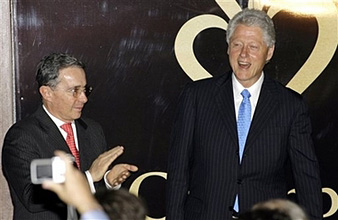 |
 |
 |
 News from Around the Americas | June 2007 News from Around the Americas | June 2007  
Colombia: A Country Reincarnated
 Malcolm Beith - Newsweek Malcolm Beith - Newsweek


| | President of Colombia, Alvaro Uribe Velez applauds after former President Bill Clinton received the 'Colombia Is Passion' award in New York, Friday, June, 8, 2007. The award, which represents the heart of the Colombian people's passion, is presented to foreigners who have revealed and promoted the positive aspects and good image of Colombia. (AP/Stuart Ramson) |
For years, Colombia has been virtually synonymous with anything bad—kidnappings, homicides, crime, cocaine, civil war and the escapades of Pablo Escobar, the drug kingpin from Medellín who terrorized the country in the '70s and '80s. But Colombia is beginning to reinvent itself in the eyes of the world.

President Alvaro Uribe Velez began a security crackdown in 2002, expanding the military in order to combat left-wing guerrillas after his predecessor’s attempts at peace talks failed. As a result, kidnappings have dropped by an estimated 78 percent since his election. Medellín, which had the highest homicide rate per capita in the world at various times during the 1980s, now has a lower rate than Washington, D.C. The drop is largely attributed to Uribe’s campaign to boost security in urban areas.

The payoff came last year. Boosted by exports of coffee, textiles and flowers, the Colombian economy rose 6.8 percent, its highest growth rate since 1978. Medellín is establishing itself as a regional commercial hub, hosting Philip Morris, Toyota, Renault and other multinational firms. Paisas, as Medellín’s residents are known, continue to grow their famous flowers, of course, celebrating the industry every summer with a citywide flower festival.

In many respects, Colombia appears to be trading places with Mexico, where crime is on the rise, the economy is down and the government is resorting to Uribe-style military tactics to restore order. As foreign investment in Mexico declines, Colombia is beginning to pick up the slack, doubling last year to surpass the $6 billion mark. That’s five times the rate of foreign investment of a decade ago; Mexico attracted $18 billion in foreign investment last year, but that’s only double the amount of 10 years ago. “Colombia’s growth potential is better than Mexico’s,” says Alberto Bernal-Leon, a Latin American markets expert at Bear Stearns & Co. in New York.

Tourism in Colombia suddenly seems to be brimming with potential, too. In 2005, the colonial port of Cartagena launched a worldwide PR campaign, “Colombia is Passion,” which has helped attract tourists as well as the attention of the World Tourism Organization, which will host its annual convention there this November. Royal Caribbean cruise lines recently announced plans to include Cartagena on its itineraries. The allure of the Zona Cafeteria - the coffee-producing region in the west of the country - has helped boost foreign visitors to the country by 65 percent since 2002, to about 1 million a year. Meanwhile, the Mexican tourism industry has been hit hard of late. Last year, repeated hurricanes devastated the Yucatán peninsula and scared off would-be tourists. And the protests surrounding last year’s controversial Mexican presidential elections - not to mention the government’s heavy-handed response - were equally negative PR. “In Mexico, the door has dropped out of the bottom of the tourist sector,” says Greg Benchwick, a Lonely Planet editor who specializes in Latin America. “When people see tanks rolling into a city in Mexico,” referring to the state of siege in the attractive tourist destination of Oaxaca, “they think it’s not safe to go to Mexico.”

Clearly, Colombia isn’t out of the woods. Cocaine is still produced in copious amounts in the rural regions (the drug traffic to the United States is a big headache for Mexican law enforcement), and Colombia still has its problems with organized crime, civil war and corruption. Mexico, with some 20 million tourists last year, is still leagues ahead of its southern counterpart. But for a country that’s been little more than a source of bad news, Colombia’s is off to a good start. | 
 | |
 |



